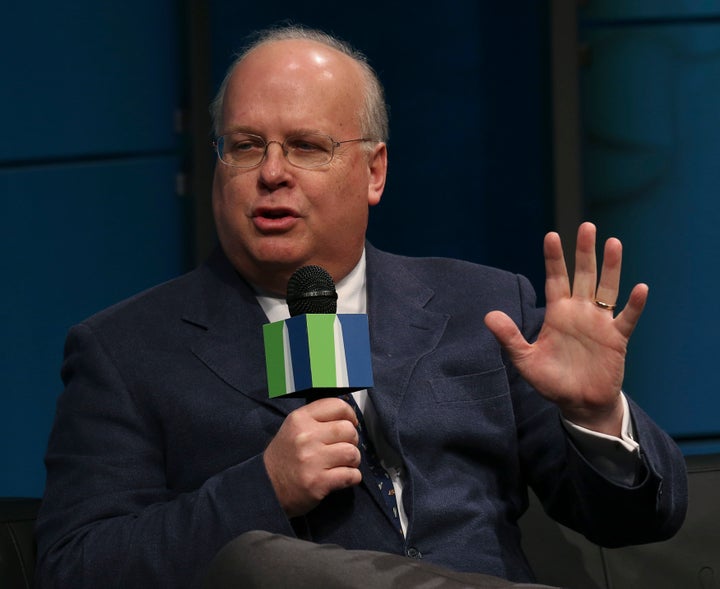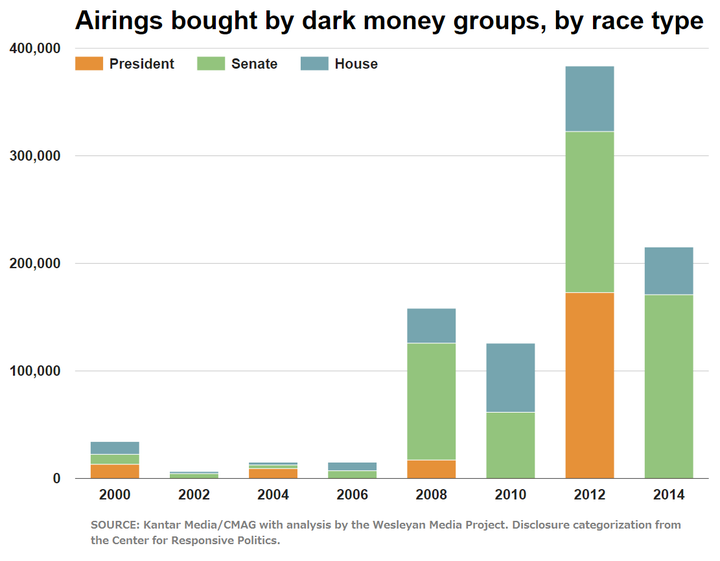
WASHINGTON ― In case there was still any argument left on the matter, a new report from the Wesleyan Media Project and the Center for Responsive Politics shows how much spending by groups that don’t disclose their donors soared in response to Supreme Court decisions that deregulated campaign finance.
Although there has been a lot of ink spilled (or keyboards mashed) showing how undisclosed or “dark” money surged following the court’s recent campaign finance decisions, this new report goes one step further by examining the actual number of advertisements these groups ran from 2000 through 2016. This unprecedented look at dark money shows definitively that there can be no other reason for the dark money surge than deregulatory court rulings.
In the 2000 election, dark money nonprofits aired more than 34,000 advertisements, according to the report. This number dropped by half to slightly above 15,000 for both the 2004 and 2006 elections before skyrocketing to over 158,000 in 2008. By the next presidential election in 2012, dark money groups ran over 383,000 ads. You can see these surges in the chart below.

What the report shows that is new is that the surge in dark money spending was not an illusion created by new disclosure rules enacted in 2002.
That year, Congress passed and President George W. Bush signed the Bipartisan Campaign Reform Act, more popularly known as McCain-Feingold after its bipartisan Senate co-sponsors, John McCain and Russ Feingold. It included requirements that independent groups, like nonprofits or 527s or even political party committees, disclose their election spending within certain windows before an election. This disclosure requirement even included spending that simply named candidates immediately before an election.
Previous examinations of the surge in dark money looked at this disclosed spending. The new report’s look at actual advertisement airings adds a new wrinkle to this by providing a measure that goes back before the McCain-Feingold disclosure requirements were put in place.
Or as Robert Maguire, political nonprofit investigator for the Center for Responsive Politics, says, “This shows more conclusively than any study done in the past that there really is a change in quantity that goes along with court decisions and the lack of oversight of these groups that has allowed nonprofit groups to be a much more tantalizing vehicle for people who want to hide their political spending.”
The two surges, first in 2008 and second after 2010, came in response to two Supreme Court decisions and one rule-making by the Federal Election Commission that significantly loosened campaign finance rules.
In the 2007 Wisconsin Right to Life case, the court ruled that certain nonprofit corporations could spend corporate money on electioneering so long as it stopped short of calling for the election or defeat of a candidate. This is what we’d call “issue ads.” The FEC followed up this ruling by gutting a new regulation imposed by the 2002 McCain-Feingold campaign finance reform law requiring all independent groups spending money on elections to disclose their donors.
Then in 2010, the court ruled in the Citizens United v. FEC case that corporations and unions could legally spend unlimited sums of money on elections so long as it remained independent from candidate campaigns and political parties. Although the court’s ruling included a strong endorsement for donor disclosure, the ruling essentially lifted a major obstacle to dark money in elections by allowing nonprofits to use corporate donations to fund express electoral expenses.
Why does this even matter? Well, those connected to dark money groups have repeatedly defended the practice by stating that they were simply trying to level the playing field.
In particular, Karl Rove, who helped launch the dark money nonprofit Crossroads GPS, which came under fire from Democrats, argued in the Wall Street Journal that “liberal groups have operated for decades in the same way GPS does without Democrats complaining.”
Although it is certainly true that both Democratic and Republican nonprofits did operate similarly by spending money on elections without disclosing their donors before Crossroads GPS formed, they did so at a wildly lower volume than Crossroads GPS and other groups did after the Supreme Court loosened the rules. That increased volume has been largely driven by groups that popped up after court rulings ― like Crossroads GPS.
In fact, Crossroads GPS, founded in 2010, has aired more ads than any other independent group from 2000-2016. The conservative nonprofit aired more than 207,000 ads, according to the report. That is 50,000 more ads than the second most prolific ad buyer, the U.S. Chamber of Commerce.
Once defended by Rove as a grassroots conservative nonprofit, Crossroads GPS has practically disappeared as a political force since it nearly lost its nonprofit status ― the very thing protecting it from disclosing its donors. The group’s tiny staff, however, has moved on to another nonprofit called One Nation. The new group has only run ads in the 2016 election, but it is already in the top 30 among all independent spenders.
“The idea that Crossroads or any of these groups are active in the same way that a handful of groups were active in the past is absurd,” Maguire says.
And now there’s a study to prove it.
